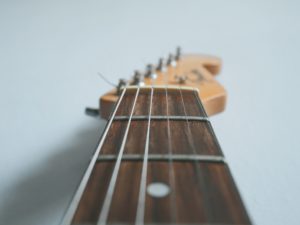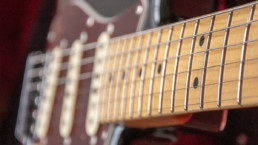Navigating The Grid
The guitar neck is a grid.
It’s the only instrument that offers so many ways to get to the same place. It’s a little like getting around Manhattan. Even a newcomer could easily find their way from 14th & 2nd to 72nd & 6th once they’ve gotten oriented. To quote a song of my grandfather’s generation, “the Bronx is up and the Battery’s down”. Once you know the layout, you can take any number of routes to the same destination.
Move to a new city and you’ll need to learn your neighborhood and a couple routes to the store. More options appear with time and experience.

On the guitar, maybe that means you can play open chords on the first three frets.
You may have learned how to get to a different area and find a few landmarks. You might know all five shapes of the pentatonic scale by heart, but you might still find it challenging to improvise a coherent solo.
This is the main reason why so much of guitar is memorizing shapes, and why so many people never go past that point. Shapes are great as landmarks and signposts: “you are here”. Music has a shape too, of course, and so skilled players learn to think of the contour of the line rather than the geometry of the neck. This is a direct and mappable relationship, and something that naturally gifted people seem to grasp intuitively.
But it also explains why practicing scales doesn’t teach you to play melody. A scale is a linear gesture: a sequence of notes rising or falling by increments of one letter at a time in most cases. A scale fingering on a guitar is more like hopscotch, or doing the Time Warp (just a jump to the left, and a step to the right…).

To a beginner, there’s nothing linear and straightforward about a scale fingering on guitar.
By contrast, most people can easily grasp how to plink out do-re-mi on a piano: Find the white key C, then the next white key to the right, and do it again. Right is up, left is down. A guitar is both upside down AND backwards in comparison before we even consider crossing strings.
But a guitar is just as linear if you stay on one string. Frets provide measurable increments: one fret a half-step, two frets a whole step, and so forth. Start paying attention to distance on a single string. The scale box is one option, but anywhere along the way you can choose to just move along the same string. If you are learning scales, great! Keep doing it. There are a variety of reasons why it’s worth your while. But practice contour and line also.
A great way to do this is to learn simple melodies in different places around the guitar. Nursery rhymes, jump rope rhymes, your alma mater’s fight song, or the first ten pages of that old Mel Bay book you might have laying around. Most will use just a few notes, so we can concentrate on the line itself.

Try this exercise:
Touch any string at the fourth fret. Play that note, then sing it. Then sing the word “three”, and see if you can find the first three notes of “Three Blind Mice”.
I’m going to predict that once you’ve done this a couple of times, that fourth fret note is going to sing out “THREE…” and you won’t be able to un-hear it. That’s the point. We just put a dot on the map, and noted a particular relationship: a major third from an open string.
But if you prefer to call it the Three Blind Mice note, that’s ok too. The point is to hear that particular relationship between two notes, and to see a pattern rather than two discrete locations.
You can extend this exercise to any musical gesture. Moving left, right, up, or down on a guitar neck produces a predictable result. You can connect that visual shape to a sound.
These patterns are consistent across the neck, with an adjustment for the second string because of the major 3rd between the G and B strings. There may be numerous options, but the interval shapes and scale boxes ARE finite.
The element that opens those boxes into infinite possibilities is melody. Following a musical line lets you connect smaller segments of a scale instead of just cycling the sequence. Focusing on up and down and the “shape” of a melody helps you phrase, because it organizes the musical ideas.
Interested in learning to solo on guitar? Check out JamPlay.com. JamPlay has over 450 guitar courses from 120+ instructors, and online guitar lessons tailored to every skill level, music genre, and playing style. Click here to learn more.
Dave Isaacs has established himself as a guitar teacher extraordinaire, having built a strong set of educational curriculums for beginner, intermediate, and advanced guitar players alike. Dave shares his expertise largely through video platforms, but also through his thoughtful writing. You can take guitar lessons from Dave Isaacs via his comprehensive video guitar courses on JamPlay.com.
Share this
Become a JamPlay member for unlimited access to 7000+ guitar lessons and 120+ artists and instructors. View membership plans ›




